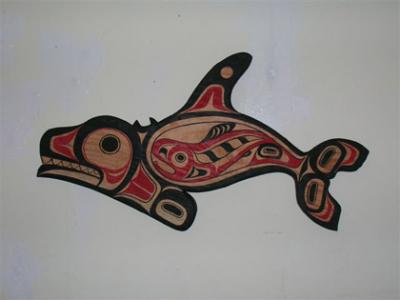
Canoes of Spirit

Chez VHP is recovering from a New Year’s Day medical emergency, so I am revisiting an earlier column that proved popular with my dear readers.
"Killer whales are the canoes of spirits, and if shamans are lucky, they get these spirit canoes." A Sitka villager uttered these profound words a century ago to the ethnographer James Swanton. To us (Odin and Orca Annie), killer whales are sacred. Life with orcas rejuvenates our bond with the Divine.
Reverence for animal relations and the natural world is our First Nations ancestral legacy. Nanih Waiya (Choctaw for "Creator") endows all creatures with exceptional talents. Humans do not possess exclusive dominion over Mother Earth and her inhabitants.
Killer whales are celebrated in the culture and spirituality of Northwest Coast Natives, many of whom have Killer Whale clans. For 10,000 years or more, Coastal Native wisdom, stories, and art have shown a sophisticated understanding of orcas that Western thought is just beginning to grasp.
The Tlingit word for killer whale is Kéet. The story "Natsiclané," or "Creation of the Killer Whale," portrays Kéet as a noble, perfect creature – what humans should aspire to be like. The relationship between orcas and their food, salmon and seals, is hallowed. In Haida cosmology, killer whales are not mere human beings, but Ocean People. Killer Whale Chiefs of important reefs married Creek Women of adjacent streams containing vital salmon runs. The fish "children" left their father’s house and migrated to their mother’s house at the stream’s headwaters. The Haida word S’gana means both "killer whale" and "supernatural power."
In several encounters with Southern Resident orcas at Point Robinson, we watched with pride and amusement as the S’gana pulled the humans along the shore like a magnet. Pungent orca breath wafted to our faces and noses on the stiff wind. Sharing the air, we truly became one with the killer whales.
In Tlingit art, the killer whale’s blow embodies spirit. The forceful spray of water vapor and air is not just physical, but animate. Human-like creatures and spirit faces radiate from the blowhole and give shape to the whale’s exhalations.
Other mystical creatures often appear inside or around the killer whale’s body. These may represent fluke prints of surfacing whales, water flowing off the whales’ backs, other entities, or even phosphorescence.
The Western paradigm seems lacking in words to describe the peak experience of interacting with orcas. In a time when cynical, mainstream culture seems more disconnected than ever from nature, orcas still affect people in ways that transcend the mundane.
Native people discovered early on that killer whales might surpass two-leggeds in intelligence. Orcas are perpetually teaching us, humbling us with novel insights. Witnessing intimate moments in orca society has been a privilege. After decades of observation, we conclude that no social order is more harmonious than that of killer whales. We are troubled that the fate of the higher-functioning species may be in the hands of the less competent species.
One crucial measure of success in our work is how well we maintain the integrity of our spiritual union with killer whales. Our job is to pay careful attention to our teachers, the orcas, and gather valuable information about them in a non-invasive manner congruent with our Native values. With any luck, we can impart some Indigenous wisdom while we help to recover an endangered species.
We harbor no sense of entitlement that the universe owes us a living from the orcas’ suffering. The whales are not a tool for self-promotion or any political agenda. We take offense when we see behavior that dishonors and imperils what we hold sacred. To be an authentic voice for killer whales, we run the risk that people will sometimes feel threatened by our words.
Killer whales have made all the sacrifices in an unbalanced relationship with modern humans. To our endangered orcas, the canoes of spirit, we pledge to restore balance by doing what we can to prevent their extinction and leave their home intact, if not substantially improved, for generations to come.
Please support the work of the Vashon Hydrophone Project (VHP): REPORT LOCAL WHALE SIGHTINGS ASAP TO 463-9041. Reporting directly to the VHP sustains an ongoing, accurate dataset of whale sightings for Vashon-Maury and Central Puget Sound waters, initiated three decades ago by researcher Mark Sears. Call the VHP about seal pups as well as dead, injured, or sick marine mammals on Island beaches. Check for updates at www.Vashonorcas.org and send photos to Orca Annie at Vashonorcas@aol.com.
- Login to post comments
